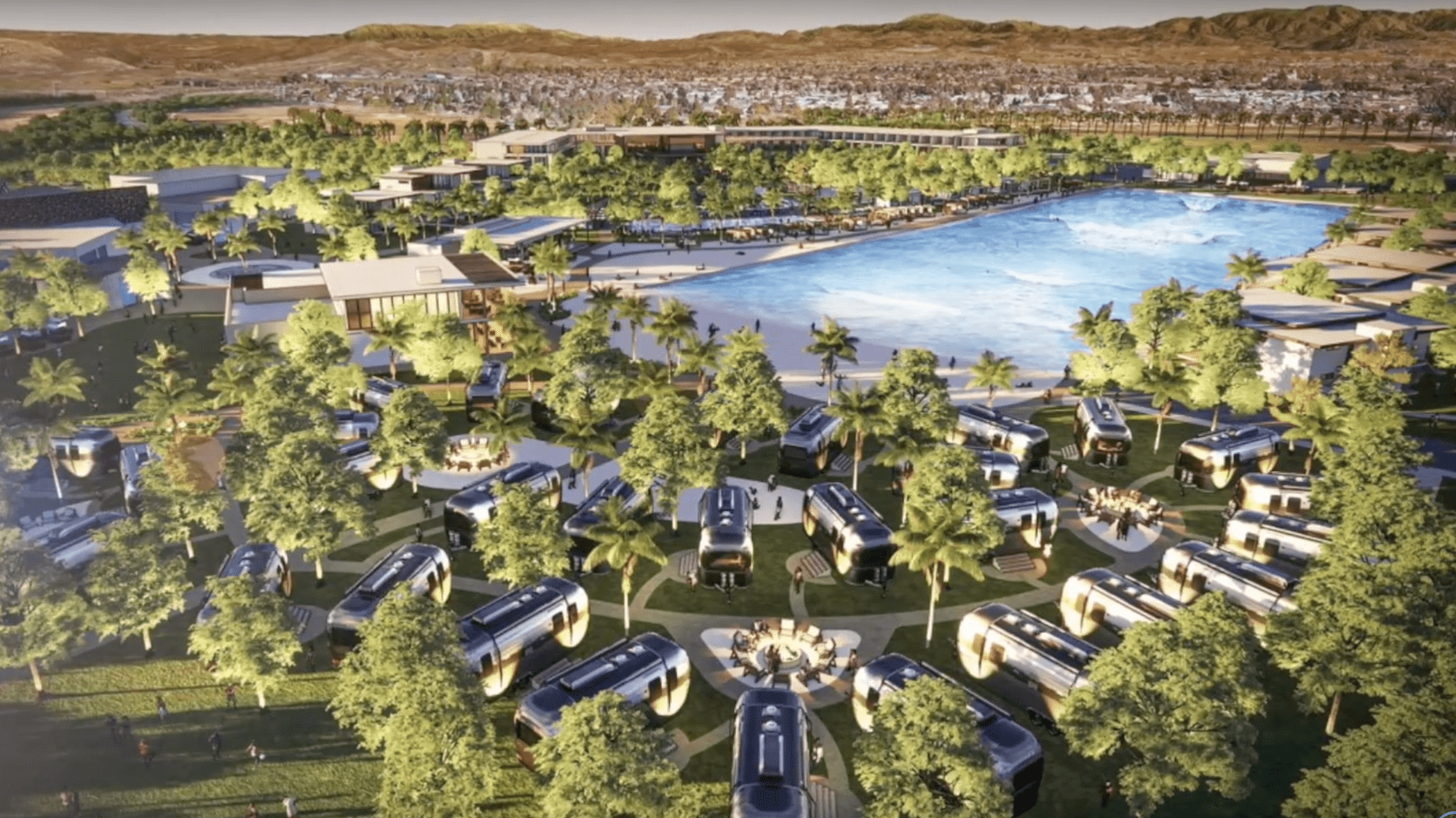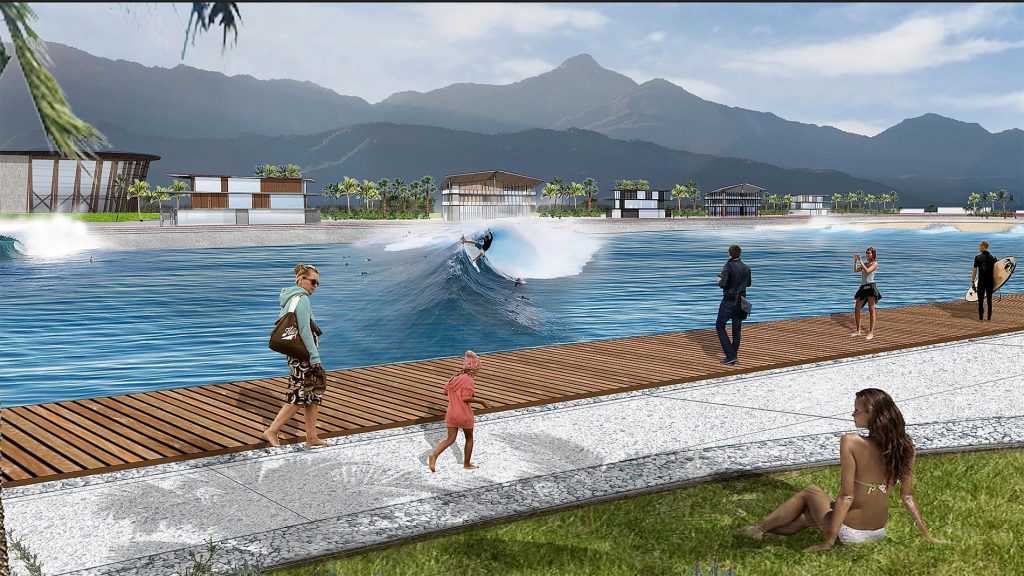Oceanside city council green lights surf lagoon (finally)

Editor’s Note:The land around Ocean Kamp is undergoing construction as we speak. We get a handful of reports from neighbors and surfers in the area. Most often the report is something like: “lots of dirt moving equipment, but no wave pool yet.” We get hit up regularly with requests, “any updates on the O-Side pool?” Well now, after a year of silence, yes we do have information on Oceanside, the pool is a Go. Anna Dimond reports on this advancement that will see the site of the old drive in theatre become Airstream trailers, 700 housing units, and a new wave pool of unspecified technology – all neatly packaged as part of a “California Lifestyle Community Development.”
More than three years since developers first submitted their proposal to build Ocean Kamp, an adventure-focused hotel, residential community and surf lagoon in Oceanside, California, the city’s planning commission has unanimously approved it.
The former site of the Valley Drive-In theater and swap meet at Mission Avenue and Foussat Road filed its first environmental report in 2008. At that time there was no wave pool in the mix, just a shopping complex called The Pavilion – a dense cluster of big-box stores and retail with a Target at its core. Some reports cite Target’s decision to pull out as the reason that the initial project dissolved.
Debate over the promise—and perils—of the project has been heated since Zephyr, the original development company behind it, bought the land and unfurled their plans. The group, which has since sold the project to their former partners, N4FL, purchased the 92-acre parcel.
Located at the northern edge of San Diego and just south of Camp Pendleton (home of a fabled, fabulous military-access-only surf break) Oceanside has long been home to a vibrant surf culture. But with the military base stretching out on one side and the oh-so-cute towns of North County to the other, it’s also often bypassed as a surf destination. For Ocean Kamp’s champions, the wave-centric behemoth might just change that.
Erik Bruvold, chief executive officer of the San Diego North Economic Development Council called Ocean Kamp “a unique development. It has the opportunity to create a real sense of place and destination in Oceanside.”
Planning Commissioner Tom Morrissey, meanwhile, was unabashedly enthusiastic. According to the San Diego Tribune, he described the surf-destination-to-be “the greatest project I’ve seen here in a long time.” He added, “It just fits in with our Oceanside history.”
Not everyone in attendance at the commission meeting, however, was bullish on the prospect of land-bound waves. Diane Nygaard, the president of a local non-profit, compared the surf lagoon to a “giant toilet flush.” A cadre of local tradespeople also opposed the project, asking for a work agreement prior to approval.
Others have also expressed salty views on the chlorinated plans. In an interview with the San Diego Reader, Chemistry Surfboards shaper Will Smith, for example, didn’t mince words. “They call it a surf lagoon,” he said. “I call it a land grab for people who want to gobble up that land and create sellable real estate.” Chemistry crafted a wave-pool board model at the hest of Cheyne Magnusson, who helped design Waco Surf (formerly BSR) in Texas.

Despite the grumbling from some corners (and barring an appeal) Ocean Kamp is officially a go. The only thing left to do then, is get building. In addition to the surf lagoon, the development will have a mix of lodging (hotel, villas, casitas as Airstreams), as well as condos, office buildings, commercial and retail spaces, and on-site yoga, bike and walking paths, among other amenities.
The surf pool, however, will be the main attraction. And the wave technology? Based on sketches from Ocean Kamp visitors will likely be shredding waves from SurfLoch (See more info below). But there has been no official confirmation to date and these things can change quickly as new surf systems enter the market most notably Endless Surf.
Now that they have the green light, Grehl and co. expect to open their doors in 2024. If that seems like an eternity, welcome to the world of wave pool development. Until then, Oceansiders can continue to enjoy the resource they’ve had all along, complete with the unpredictability of nature: miles of Pacific coastline—no City Council approval needed.
About SurfLoch
SurfLoch’s technology uses pneumatic systems within big caissons (a watertight concrete or metal chamber) that push out air to displace water and create a wave. When wave programmers fire the chambers in a specific sequence, any number of wave types can be created. The test pool at Palm Springs Surf Club has six to eight of these chambers, a full-size SurfLoch design can go up to 24 chambers.
Wave sizes range from 2-to-6-feet with the ability to go bigger in the right setting. Waves can be created to break right, left or as a central peak producing both a right and a left. The length of the ride depends on the size of the pool and the number of swell-producing chambers. The Palm Springs test pool offers six-second rides but the full-scale pool will offer 16-second rides. The system is controlled by software designed by industry heavyweight Siemens. Tom’s technology is benefitting greatly under the knob-twirling of Cheyne Magnusson who created many of BSR Surf Resort’s branded wave settings. Surf Loch currently has projects ongoing in Spain, Australia, The USA and beyond.
Related Coverage
